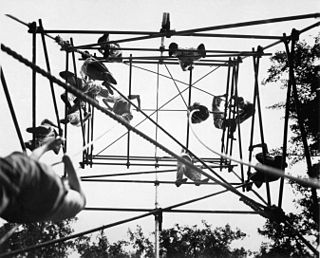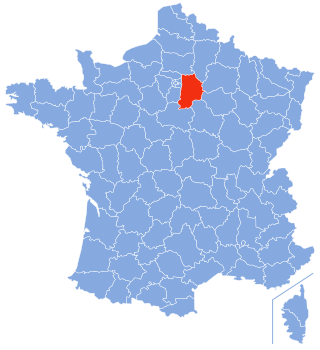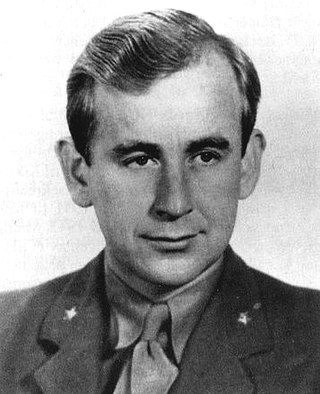Related Research Articles
Special Operations Executive (SOE) was a British organisation formed in 1940 to conduct espionage, sabotage and reconnaissance in German-occupied Europe and to aid local resistance movements during World War II.

Operation Jedburgh was a clandestine operation during World War II in which three-man teams of operatives of the British Special Operations Executive (SOE), the U.S. Office of Strategic Services (OSS), the Free French Bureau central de renseignements et d'action and the Dutch and Belgian armies in exile were dropped by parachute into occupied France, the Netherlands and Belgium. The objective of the Jedburgh teams was to assist allied forces who invaded France on 6 June 1944 with sabotage and guerrilla warfare, and leading local resistance forces in actions against the Germans.

The Norwegian heavy water sabotage was a series of Allied-led efforts to halt German heavy water (deuterium) production via hydroelectric plants in Nazi Germany-occupied Norway during World War II, involving both Norwegian commandos and Allied bombing raids. During the war, the Allies sought to inhibit the German development of nuclear weapons with the removal of heavy water and the destruction of heavy-water production plants. The Norwegian heavy water sabotage was aimed at the 60 MW Vemork power station at the Rjukan waterfall in Telemark.
Milorg was the main Norwegian resistance movement during World War II. Resistance work included intelligence gathering, sabotage, supply-missions, raids, espionage, transport of goods imported to the country, release of Norwegian prisoners and escort for citizens fleeing the border to neutral Sweden.
Norwegian Independent Company 1 was a British Special Operations Executive (SOE) group formed in March 1941 originally for the purpose of performing commando raids during the occupation of Norway by Nazi Germany. Organized under the leadership of Captain Martin Linge, it soon became a pool of talent for a variety of special operations in Norway.

Vemork is a hydroelectric power plant outside the town of Rjukan in Tinn Municipality in Telemark county, Norway. The plant was built by Norsk Hydro and opened in 1911, its main purpose being to fix nitrogen for the production of fertilizer. At opening, it was the world's largest power plant with a capacity of 108 megawatts (145,000 hp).

The Iron Ore Line is a 398-kilometre (247 mi) long railway line between Riksgränsen and Boden in Norrbotten County, Sweden, owned by Trafikverket. The line also contains two branches, from Kiruna to Svappavaara and from Gällivare to Koskullskulle. The term is often colloquially used to also include the Ofoten Line, from Riksgränsen to Narvik in Norway, and the northernmost part of the Main Line Through Upper Norrland from Boden to Luleå. The railway from Narvik to Luleå is 473 kilometres (294 mi) long.

Lise Marie Jeanette de Baissac MBE CdeG, code names Odile and Marguerite, was a Mauritian agent in the United Kingdom's clandestine Special Operations Executive (SOE) organization in France during World War II. The purpose of SOE was to conduct espionage, sabotage, and reconnaissance in countries occupied by the Axis powers, especially Nazi Germany. SOE agents allied themselves with resistance groups and supplied them with weapons and equipment parachuted in from England.

Claude Marie Marc Boucherville de Baissac, DSO and bar, CdeG, known as Claude de Baissac or by his codename David was a Mauritian of French descent who was an agent of the United Kingdom's clandestine Special Operations Executive (SOE) organization in France during World War II. The purpose of SOE was to conduct espionage, sabotage, and reconnaissance in countries occupied by the Axis powers, especially Nazi Germany. SOE agents allied themselves with resistance groups and supplied them with weapons and equipment parachuted in from England.

Yvonne Yvette Fontaine, also known as Yvonne Fauge, code named Nenette and Mimi, was a member of the French Resistance and an agent of the United Kingdom's clandestine Special Operations Executive (SOE) organization during World War II. The purpose of SOE was to conduct espionage, sabotage, and reconnaissance in occupied Europe against the Axis powers, especially Nazi Germany. SOE agents allied themselves with resistance groups and supplied them with weapons and equipment parachuted in from England.
Ragnar Leif Ulstein MM was a Norwegian journalist, writer and resistance member. He wrote several documentary books from the Second World War, including surveys of the SOE group Norwegian Independent Company 1, volunteers sailing from Norway to Scotland, refugee traffic from Norway to Sweden, and military intelligence in Norway.
Roy Nielsen was a Norwegian resistance member during World War II, a member of Milorg and involved in propaganda and sabotage. Among his sabotage operations was the destruction of 25 Messerschmitt fighter aircraft and 150 engines stored in a bus garage in Oslo, on 14 August 1944, together with Max Manus, Gunnar Sønsteby and others. Together with Max Manus he succeeded in sinking the German troop ship SS Donau in the Oslofjord 16 January 1945, by placing magnetic limpet mines with time delay on the ship's side.
Operation Sunshine was an anti-demolition operation in occupied Norway from October 1944 to May 1945. It was planned by Norwegian military personnel in the United Kingdom in cooperation with British forces, and part of an effort to protect essential installations and industry, in particular large power stations, against destruction in a possible scorched earth action by the Germans towards the end of World War II.

Peter Vogelius Deinboll, DSO, MC was a Norwegian engineer, and resistance member during World War II.

Operation Mardonius was a military operation directed against German ships in occupied Norway, planned and carried out in 1943 by the British Special Operations Executive (SOE). The outcome of the operation was sinking of two ships in the harbour of Oslo, Ortelsburg of Hamburg and Tugela.
Hans "Kyllingen" Storhaug, MM, DSM was a Norwegian resistance member during World War II, especially noted for his role in the heavy water sabotage 1942–1943, and for his participation in the SOE operation Grebe and Grebe Red in Østerdalen 1943–1945.
Birger Rasmussen MC & Bar was a Norwegian businessman, director of Katfos Fabriker, manager of Borregaard's pulp and paper section, director of Follum Fabrikker, and president of the Federation of Norwegian Industries.
Marie-Thérèse Le Chêne MBE CdG was a French civilian who was an agent of the United Kingdom's clandestine organization, the Special Operations Executive (SOE), in France during the Second World War. She was the oldest female SOE agent sent to France, serving there from 31 October 1942 until 19 August 1943. She worked as a courier with the code name of Adele. Her husband and brother-in-law were also SOE agents and she worked closely with them.
Operation Chaffinch was a World War II mission conducted by a branch of the British Special Operations Executive (SOE) called Company Linge, which was a Norwegian group. The operation aimed to make contact with local resistance groups in the Oslo area and to sabotage shipping. The operation succeeded in sinking the merchant vessel Sanev on 19 May 1943.
References
Citations
- ↑ Herrington 2004, p. 324.
- ↑ O'Connor 2016, p. 137.
- ↑ O'Connor 2016, p. 141.
- ↑ Herrington 2004, p. 229.
- ↑ "Kestrel | Operations & Codenames of WWII". codenames.info.
Bibliography
- O'Connor, Bernard (2016). Sabotage in Norway. Lulu.com. pp. 136–142. ISBN 978-1291380224.
- Herrington, Ian (2004). The Special Operations Executive in Norway 1940-1945: Policy and Operations in the Strategic and Political Context (PDF) (PHD).